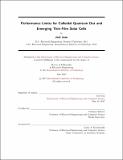Performance limits for colloidal quantum dot and emerging thin-film solar cells
Author(s)
Jean, Joel, Ph. D. Massachusetts Institute of Technology
DownloadFull printable version (67.87Mb)
Other Contributors
Massachusetts Institute of Technology. Department of Electrical Engineering and Computer Science.
Advisor
Vladimir Bulović.
Terms of use
Metadata
Show full item recordAbstract
Emerging thin-film solar photovoltaic (PV) technologies can be made lightweight and flexible with simple manufacturing methods, allowing rapid scale-up and ubiquitous deployment of solar power. However, for most emerging PV technologies-including colloidal quantum dots (QDs), perovskites, and organics-power conversion eciency and stability remain major obstacles to commercial development. In this thesis, we evaluate the long-term potential of emerging thin-film PV technologies, focusing on performance limits for QD solar cells in the face of inefficient charge extraction and energetic disorder. First, we introduce material complexity as a framework for analyzing PV technologies and assess the performance and scalability of all leading technologies on equal footing. This analysis points to a unique advantage of emerging thin films-high power-to-weight ratios. As a proof of concept, we demonstrate a process for producing thin, lightweight, transparent, laminable, and flexible PV substrates based on in situ vapor-phase growth of parylene-C films. This approach enables ultra-thin molecular organic solar cells with efficiencies and yields comparable to glass-based cells and weight-specfic power exceeding 6 W/g. Next, we address inefficient charge extraction in QD solar cells by demonstrating an ordered bulk heterojunction device architecture based on solution-grown ZnO nanowire arrays and PbS QDs. The nanowires decouple light absorption from charge extraction, improving the short-circuit current density by 50% and the power conversion eciency by 35%. Finally, we attempt to answer the question "Are QD solar cells worth pursuing further?" We use photothermal deflection spectroscopy to characterize disorder-induced band tailing in PbS QD films across dierent QD sizes, ligands, and processing conditions. Based on these measurements, we calculate radiative eciency limits ranging from 26% to 32%, which suggests that disorder does not severely constrain the long-term potential of PbS QD solar cells.
Description
Thesis: Ph. D., Massachusetts Institute of Technology, Department of Electrical Engineering and Computer Science, 2017. This electronic version was submitted by the student author. The certified thesis is available in the Institute Archives and Special Collections. Cataloged from student-submitted PDF version of thesis. Includes bibliographical references (pages 200-224).
Date issued
2017Department
Massachusetts Institute of Technology. Department of Electrical Engineering and Computer SciencePublisher
Massachusetts Institute of Technology
Keywords
Electrical Engineering and Computer Science.